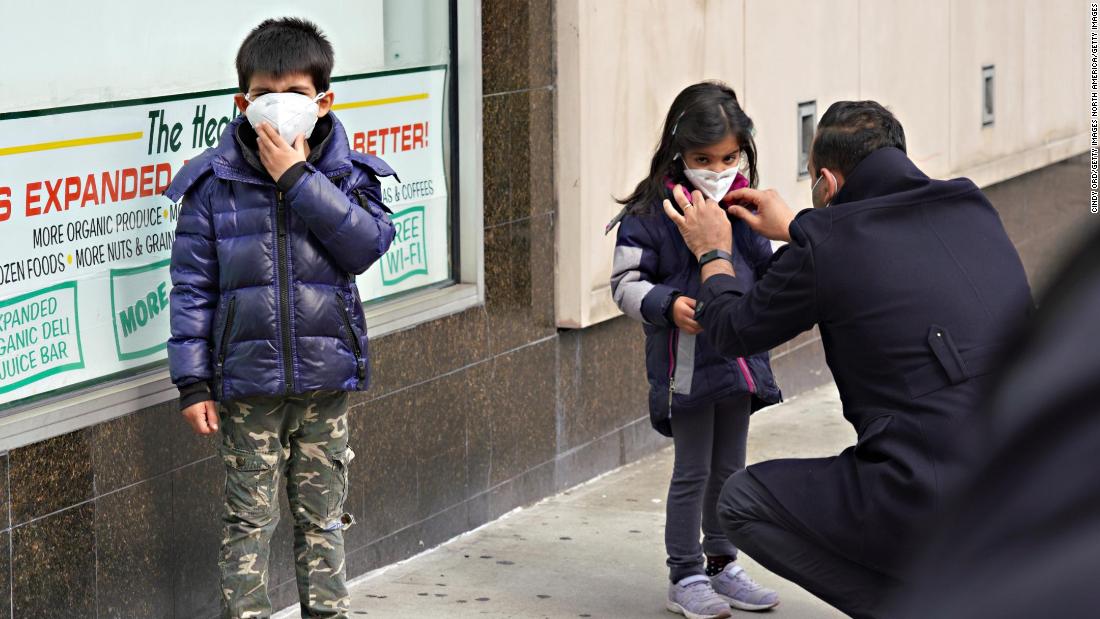What Matters: Here’s what’s going on in your kids’ minds
[ad_1]

But a big unanswered question is how children are going to remember this period and how it will affect them, because there are difficulties, frustrations and dangers in having most of the nation’s kids out of the classroom that go way beyond whether their parents are able to successfully complete a Zoom meeting or safely leave the house to go to an essential job.
To understand a little better, CNN went to Dr. Bonnie Goldstein, a clinical psychologist in Los Angeles, who once wrote a children’s guide to coping with natural disasters.
Little kids
Redefine a deadly virus
CNN: My six year-old keeps calling it “the deadly virus.” And she’s laughing when she says it, but it’s a really heavy way to look at it. It makes me wonder, how do kids internalize it and deal with it differently than adults and how should adults be viewing it for their kids? And will an entire generation be marked by this?
BG: Every child varies. Kids tend to either be anxious about it, depressed about it, or avoiding, just not even aware or in denial of it. For your sweet six-year-old who’s saying “the deadly virus,” ask her what’s that mean and see what she says. And you can help reframe that. I would call it a really bad virus that a lot of people are recovering from. Why do you call it a deadly virus? Is that something you heard from me? … Maybe the whole family can shift the whole nomenclature to the virus. Or the “yucky virus.”
A collective impact
CNN: But from a lasting perspective, this isn’t internment camps. It’s not World War II. But it’s still very strange what’s happening. Does it have this sort of collective impact on kids that it doesn’t have on adults?
BG: I would say all kids are different yet kids are as resilient as the parents or the caretakers who can help them reflect on and make logical coherence of the situation. So if you can get them telling narratives and stories, you’re able to help turn down their anxiety.
Our kids can sense us vibrating on a different level
BG: I do think that our bodies through the lens of sensorimotor psychotherapy or somatic body-based work — our bodies vibrate at a different level right now. I think we are all having an ever so slight vibration of anxiety in our bodies that we’re waiting for the news, avoiding the news but that’s an act of avoidance, we’re wondering what will happen, we’re anticipating negative.
Chances are a younger child has heard a parent say, well we get to do this, but we don’t know, or it’s getting better but it’s not, or it’ll come back even worse.
They’re hearing messages that some things have changed forever like hygiene. I believe most kids will clean differently. I think there will be a lot less hugging and physicality, at least in the near future or perhaps this will be a way of life.
Technology is OK
BG: But also this is the first time I’ve ever heard parents — and I work with a lot of clients and their families — I’ve never heard parents encouraging technology the way I have now. Instead of, “you’re on your device too much,” now it’s “get on your device, you have Zoom,” or “get on your device, connect with friends.”
And also more good things are happening. As much as bad things are also happening on the Internet, there are also wonderful offerings even on YouTube. You’re seeing things that are affirming that couldn’t have happened before. I think that as a collective community, this is our war.
A war on our land
BG: Other than 9/11 this is the war on our land that affects everybody. And after 9/11, the children who are now 20, 21, 19, were very affected very much by that. My daughter who’s 19 was one when it happened. She doesn’t remember it that I’m aware of and yet she’s affected by it… And this illness does the same thing — “we’re not safe” — but we’re also learning that there are things you can do to be safe.
Cementing inequality
CNN: Not every parent has the luxury to stay home and guide their kids through this. Will this cement inequality in the country and is it going to affect kids in certain communities more than others?
BG: We’re already seeing the cultural implications of this virus, which is exponentially greater for impoverished communities, for many minority communities, for families with many family members in the home, for many first responders, and people who are much more out in the world.
I’m busier than I’ve been in my life — old clients, new clients, all on Zoom, but I don’t risk catching the virus the way so many other families who don’t have any other choice do.
The levels of inequality are growing greater, and I don’t have answers to that because I think it was a broken system to start with.
Their brains are developing, but they can be surprisingly mature
CNN: Is the way a kid’s brain works differently than the way my brain works to figure out how to deal with this stuff?
BG: Yes. There are many developmental stages … Things are very concrete, say, for a six-year-old and even younger where death is still just on the edge of understanding.
Some really understand it because they’ve had trauma and they’ve had to grasp it.
Others have never really been exposed to it. My analogy would be a cartoon character who gets killed over and over and over again may be the entree to death for a child. But then they’re there the next day. And another child may have huge loss and trauma in their life where it’s been discussed and they have an understanding. And then there are other kids where there is huge trauma and loss and no one discusses it based on the culture in the household and from the way the family communicates, based on who is and isn’t there and based on family secrets.
The brain of a younger child is very different than our brain, but often very surprisingly mature and you never know what differs from brain to brain.
Teens are like Martians, but they’re living in your house
That’s everyone from 9 to 29
BG: Let’s talk about the teen brain for a second because the teen brain tends to be far more impulsive and this part of the brain the pre-frontal cortex often goes offline. And so when you’re looking at teenagers, I would define teen as say from 9 to 29 and that’s really a loose level, you know, and even more so as the boomerang kids come home and right now a lot of college kids and post-college kids are coming home to stay safe at home with their parents or are out of jobs for the foreseeable future and so are residing at home.
Some kids will be anxious
But I have an analogy that I love. I will tell a parent that although the Martians have taken their brain, they will bring it back. Because parents will say “What happened to my sweet little child,” like he or she is a monster and we want to help regulate any child in adolescence. It just starts with getting them to speak about the story, that coherence we spoke about earlier to make sense of the story: “I’m really scared. They say there’s this deadly virus. Everyone’s going to die. The planet will be gone.”
As we listen we realize there’s some fallacies there. Help them reframe it.
Some kids will be in denial
BG: And on the other extreme, there’s the ones in denial. The clients I had who went partying in Florida, who had a great time in Cabo during spring break and got so sick and shared it with their family members before they knew it and are still sick. There are people who are six or seven weeks into this virus, not dying from it, just recuperating. We know so little about it.
Some kids will feel isolated
BG: We have adults and teenagers who are feeling, not on an OCD level, rather socially appropriate washing or distancing and are feeling isolated and abandoned. Society didn’t anticipate this being this long. It was a week or two, or three or four. In their minds they will be back in school in two weeks.
The typical five stages of depression and despair that Elisabeth Kübler-Ross talks about — denial, anger, depression, bargaining and acceptance. It’s not that it happens in that order. Those five stages weave in and out.
I have clients come in totally in denial. And then they’re so angry. Then it seems they’ve accepted it and then another something happens. It happened today with prom, a girl was, tonight’s her prom. She thought she was fine with it. But she wasn’t. She woke up today so upset. It’s as though all the feelings she thought she dealt with — her dress arrived and boom, it was a visual trigger and it went right to her heart and she started panicking.
Take a breath
BG: So the first thing I did, I asked her where in her body she’s feeling this. Where in her nervous system. Because no matter how many words I say, it’s understanding the body that makes a difference. So she and I both put our hands on our heart. Because she said it wouldn’t stop beating. She was so angry. She was hot. Her face was flushed. That hyperarousal. And her heart was beating. So putting her hand on her heart, like I’m doing now, calmed her down. It shifted something for her. And for many many people it does that. But not all. If she had said this is worse I feel trapped, which is a possibility, I might have said let’s do this. Let’s open our arms wide. And when you do that — in fact try, it for a second. Try it with your arms. Now take a break. Take a breath like this. You see how much more open it is when you do that?
CNN: Yeah. It’s great. (Really, it was.)
BG: Go back and this time (crosses arms), head down, tight tight. Now try to take the same breath. See how hard it is with your breath constricted. Many people walk around angry like this, head down, scared, and they can’t breathe.
There’s chaos in not knowing what’s going to happen
CNN: You said you’re busier now than ever. What’s going on?
BG: I would say most of my colleagues share with me the sense that initially we thought we knew what we were dealing with and we were helpless.
And then new information came and a whole wave of helplessness. And then we got a little more competent or confident on this roller coaster and then yet more of a sense of helplessness as it continued.
I don’t think any of us thought we’d be home this long except those who thought we’d be home forever. Somewhere between one week and two years is the truth. We’re starting to lighten up. But we’re not near the end.
Two extreme ways to view opening back up
CNN: As states start to open up, is there more comfort among people right now?
BG: Some are more comfortable and others are more fearful. The fear is we’re going to open up, we’re all going to get sick, we’re going to die. The other side is already, finally we’re opening up, it’s about time. Herd mentality. Let’s all get on with it. Some will go, some will live but this is not good for our economy and without an economy what point is there? So two very different extremes. And here’s what we want — and this is back to something Dan Siegal speaks of — we’re looking at the chaos of it’s awful, it’s terrible, this is never going to get better. And then the other end of the chaos is what a waste this has all been.
We don’t know what the truth is, but what we want, our aspiration, is to get a flow between the two.
How to help your kids
What to watch for
CNN: Have the warning signals for a child who needs help changed? Three months ago, not wanting to go outside might have meant you were a shut-in. Now it could be a perfectly rational thing.
BG: For kids of all ages, including us adult kids, every person responds differently to the paradigm of staying home. I’ve had teenagers who are so relieved because every day setting foot on campus was a social nightmare, a clothing nightmare, an emotional trauma. They’d come home exhausted not from the academics, but from navigating the social world that is elementary school, middle school, high school and I have other kids that thrived in the social milieu, it was their only respite from awful home life. So some kids respond really favorably to staying at home — “I get to be on my computer, I’m so happy.”
I’m a believer that nature and fresh air and walking is an essential, both the body based act of walking integrates your brain.
Realize some kids are loving distance
BG: Some of our more tech favorite kids who are loving technology have no need to ever go outside again, whereas some of our kids they have a physical need to run to play to move. Some of the clients who have features of attention deficit or hyperactivity or have diagnoses as such or even just wiggly squigglies, they need to have the opportunity to get the wiggly squigglies out.
So, thankfully we’re encouraged to go outside and take walks, at least in Los Angeles, with our masks. Thankfully we’re not in a war zone where it’s not safe to go outside or be inside. And that’s a differentiation from the worries that, say, people in London found in World War II.
If they’re depressed, use their vices to inspire them
BG: One thing I’ll tell parents, if your child won’t get up in the morning and your child used to be one who leaped up, the first thing I would do is I would try to help find out what is it worth getting up for. One teenager really was depressed and one of the signs of depression is you couldn’t get out of bed. But they were also starting to get addicted to their coffee. This is a good time to foster the coffee addiction. Don’t deprive the child of the coffee, but don’t bring it to their room so that they can stay in bed.
Or you give them a teeny tiny little thimble of coffee and say there’s a whole cup waiting for you. Get up, get dressed, brush your teeth.
Or don’t brush your teeth ’til after the coffee because we like the taste of the coffee. Come in with a fresh face and let’s just start our day. That’s an inspiration.
Or food. I would never right now serve a depressed child food in bed. I would encourage them to come get whatever their favorite meal is. And what’s the worst day of the week right now? Monday morning, because still kids are in school, but school is at home and the weekend is at home…
So I tell parents, “Name it to tame it.” Up! It’s a Monday morning. We’re not good on Mondays, are we? What’s your favorite food that I can serve you in the kitchen? And try to get them out of your room and up. “Your Pop Tart’s waiting!” Even though the Pop Tart is the most disgusting food on Earth. If it works…
When you’re angry, do a pushup
BG: One more great trick in session live or online, when you’re feeling really angry with your kid, do a pushup. Or do a plank. All that angry energy goes into the ground. I don’t see your face. I don’t see you yelling at me with your silent eyes. I don’t see you smirking at me because I’m doing a pushup and it allows the body to regulate.
Sit on the ground to yell
BG: And one more trick. If a parent is so angry that they’re about to explode on themselves or their kid, even though they know that doesn’t do any good for them or the kid, my deal with them is, drop it. Sit on the ground to yell. Because if you sit on the ground to yell, “I told you clean your room,” it’s very different.
It allows for a milli-moment to shift their mindfulness. To invite in self-regulation. And a kid isn’t as triggered if a parent is on the ground yelling because their eye contact is lower down.
Keep an eye out
BG: And one thing we know right now is domestic violence is way up. Huge rates of divorce, domestic violence and rates of family violence. And it’s being underreported because many of the people who report violence and domestic squabbles and physical violence to kids and child abuse are the teachers… And those people aren’t seeing the kids.
If there’s one message we want to get, it’s please be vigilant. If you hear something, please help your neighbors by calling the police. Don’t assume it’s being taken care of.
[ad_2]
Source link









